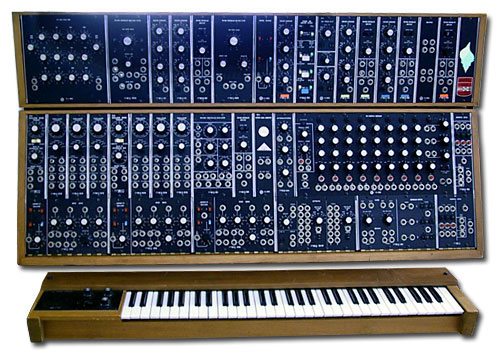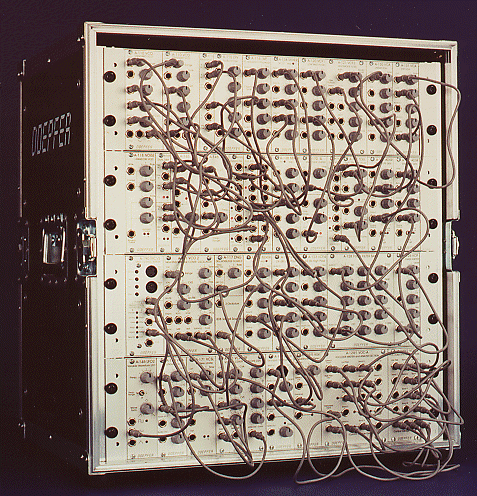What is Modular Synthesis?
Modular synthesis is a way of creating sounds through individual modules (or components), routing your signal path in any number of ways in order to build a unique and customizable syntheszier “patch”. Modules such as oscillators, filters, and envelope generators, are connected to each other using patch cables, allowing for a flexible and interactive way to shape and manipulate sound.
Think of it as a bunch of guitar effect pedals – the way you connect them together alters the sound. For example, putting your guitar through a chorus pedal before a distortion pedal would sound different than putting your guitar first through the distortion pedal and into the chorus pedal. The first one distorts a chorused guitar, the second one choruses a distorted guitar.
The history of modular synthesizers

The history of modular synthesizers dates back to the mid-20th century when pioneers in electronic music began exploring new possibilities for sound synthesis. One of the earliest contributors was Raymond Scott, an American composer and inventor who developed a range of electronic instruments, including the Clavivox and the Electronium, in the 1950s and 1960s. However, it was Robert Moog who is often credited with popularizing the modular synthesizer concept. In the 1960s, Moog introduced the Moog Modular Synthesizer, which used voltage-controlled modules that could be interconnected to create complex sound systems. This innovation revolutionized music production, and artists like Wendy Carlos and Keith Emerson quickly embraced the expressive potential of modular synthesizers. Throughout the 1970s and 1980s, other manufacturers like ARP Instruments and Buchla Electronic Musical Instruments also contributed to the development of modular systems. However, with the advent of digital synthesizers and more compact instruments, modular synthesis fell out of the mainstream spotlight. Luckily a dedicated community of musicians and enthusiasts continued to explore modular synthesis, leading to a resurgence in the late 20th century and a thriving modular synthesizer market today. The rise of Eurorack format, with its standardized size and power requirements, has further fuelled the popularity of modular systems, making them more accessible to musicians of all levels.
How was Eurorack invented?

Eurorack modular synthesizers were invented by Dieter Doepfer, a German engineer and musician, in the late 1990s. Doepfer was inspired by the traditional modular synthesizers of the past, such as the Moog Modular and Buchla systems, but wanted to create a more compact and standardized format. He introduced the Eurorack format as a response to the need for a modular system that was more affordable, portable, and user-friendly. The Eurorack format uses a consistent module size, power supply specifications, and signal standards, allowing modules from different manufacturers to be easily integrated and interconnected. This standardization brought modularity to a wider audience and sparked a new era of interest in modular synthesis. Today, the Eurorack format has become the dominant standard in the modular synthesizer community, with a vast array of modules available from numerous manufacturers.
Are modular synthesisers expensive?
Modular synthesizers can vary widely in price, depending on factors such as the brand, module selection, and overall complexity of the system. While it is possible to build a modest and affordable modular setup, it’s important to note that modular synthesis can become an expensive endeavour as you expand and add more modules to your system.
The cost of individual modules can range from tens to hundreds or even thousands of dollars, depending on their functionality and quality. Additionally, acquiring a power supply, case or rack, patch cables, and other accessories adds to the overall expense. As the modular market has grown, there are now modules available at various price points to accommodate different budgets.
However, it’s worth noting that modular synthesis offers unparalleled flexibility and sonic possibilities that are often not found in other types of synthesizers. It allows for intricate sound design, customization, and exploration, which can be highly rewarding for musicians and sound designers. It’s important to consider your needs, budget, and long-term goals when deciding to enter the world of modular synthesis. Starting small and gradually expanding your system over time is a common approach that can help manage costs while still enjoying the benefits of modular synthesis.
What are the different ways in which you can use a modular synthesiser?
Modular synths offer a wide range of creative possibilities, allowing for various ways to use it. Some of the different approaches and applications of a modular synthesizer include:
Sound Design and Synthesis
Modular synthesizers excel at sound design, enabling you to sculpt and create unique sounds from scratch. By combining different modules, you can generate a wide range of tones, textures, and timbres, exploring various synthesis techniques like subtractive, additive, FM, wavetable, and more.
Performance and Live Improvisation
Modular synthesizers can be used in live performances and improvisation settings. With their hands-on controls and real-time modulation possibilities, you can manipulate and shape the sound on the fly, creating evolving and dynamic musical performances.
Sequencing and Composition
Modular synthesizers often include sequencer modules that allow for the creation of melodic patterns, rhythmic sequences, and evolving sequences of control voltages. These sequencers can be used to compose and arrange music, providing precise control over timing, pitch, and modulation.
Sound Effects and Processing
Modular synthesizers are not limited to creating traditional musical sounds. They can also be used for sound effects and processing purposes. By applying modulation, filtering, and other techniques to external audio sources, you can create unique textures, drones, experimental sounds, and complex effects.
Experimental and Ambient Music
Modular synthesizers are well-suited for experimental and ambient music styles. Their flexibility and extensive modulation capabilities allow for the exploration of unconventional and immersive soundscapes, creating atmospheric textures, evolving drones, and intricate sonic landscapes.
Integration with Other Instruments and Systems
Modular synthesizers can be integrated into larger setups, allowing for interaction with other instruments, MIDI controllers, and computer-based systems. This integration enables you to combine the unique sound generation capabilities of a modular synthesizer with other instruments and technologies, expanding the creative possibilities even further.
